Text and photos: Rangan Datta
Mandu
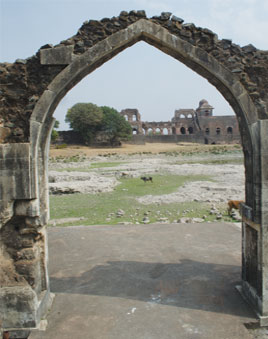
“I know of no other place that is as pleasant in climate and with such attractive scenery as Mandu in the rainy season.”
– Tuzuk I Jahangari
The citadel of Mandu is perched upon a rocky outspur of the Vindhya Range, at an altitude of 634 m. It is separated from the main Malawa Plateau by a deep ravine – Kakra Khoh – which runs on the eastern, northern and southern sides of the Mandu hill. The southern slopes of the Mandu hill has a 305 m incline and it merges into the Nimar plain, which is fed by the mighty Narmada River.
The hill range is endowed with very attractive scenery, which attains its pinnacle during the rainy season, when on all sides, it is clothed in green with a number of brooks and torrents rushing down into the ravine. The vegetation is at its best and most luxurious in the monsoon, the beauty of which is further enhanced by more than a dozen lakes and ponds.
Thus Mandu, with its natural fortification and amazing beauty has been the favorite citadel of many a ruler for a period spanning over a thousand years. For centuries Mandu has served as a frontier outpost for the north Indian rulers for their invasion into the Deccan, or to ward off invasion from the south. But most likely, it is the enchanting rugged landscape of Mandu that captured the imagination of many a king and emperor. The famous history writer John Keay describes Mandu as one of the most romantic sites anywhere in the world.
Over the centuries, the kings of Malwa region of central India, along with the Delhi Sultans and the Great Mughal Emperors, have made Mandu their abode. They have constructed mosques, pleasure palaces, hunting lodges, pavilions, tombs, gateways, inns and shops, all within the natural and man-made fortifications of Mandu. No wonder, the Muslim rulers called Mandu Shadiabad, meaning the City of Joy.
Today Mandu is a leading tourist spot in Madhya Pradesh, and attracts tourists from far and wide, throughout the year. But come monsoon, hordes of tourist will make it to Mandu in the footsteps of Humayun and Jahangir or the legendary Baz Bahadur, to enjoy the romantic beauty of the scattered ruins of Mandu with the lush green backdrop of the hills, and beneath the shadows of the dark monsoon clouds.
Today, the ruins of Mandu can broadly be classified under six categories:
The Royal Enclave
The fortified Royal Enclave, on the northern edge of Mandu plateau, is the prime attraction of Mandu. Spread over a large area, it covers a diversified assortment of ruins from stable to pleasure palaces, and from step wells to hammam, and even a mosque. This royal group of monuments was constructed by the Ghuri and Khalji dynasty spanning from 1320 to 1531. In these two centuries, Mandu experienced a unique blend of architecture, and came to be known as the City of Joy.

Jahaz Mahal: The Jahaz Mahal is not only the most prominent monument of the Royal Enclave, but also serves as the icon of Mandu. The elongated building is 360 feet in length and only 50 feet in breadth, and stands on a narrow stretch of land sandwiched between the two water bodies of Kapur and Munj Talao. The Jahaz Mahal towers above the two water bodies and in monsoon, the water reaches right up to the edge of the monument, giving it a ship-like appearance, and hence the name Jahaz Mahal.
Jahaz Mahal was probably constructed during the reign of Ghiyathuddin Khalji (1469-1500) and happens to be one of the last major monuments of Mandu. The Jahaz Mahal is an ultimate place for fun, entertainment and pleasure. On the southern end of the two-storied building, a long flight of stairs leads directly to the terrace. The main entrance is through a marble archway on the middle of the eastern side. The views from the first floor balcony, on the western side of the Jahaz Mahal, are spectacular, with the gigantic Munj Talao and the royal palace on the northern end, and the Jal Mahal on the western end.
The northern end of Jahaz Mahal houses two swimming pools, each located at the ground and first floor level. A complex system of spiral aqueducts brought water to these pools. With no electricity, it was probably the Persian wheel which lifted the water from the talao to the first floor of the Jahaz Mahal. Both the pools are shaped like the open petals of a blooming flower and were a source of ultimate pleasure for the emperor and his harem mates. A spiral water inlet brought water to the upper pool, providing an amazing jacuzzi-like experience to the emperor and his aquatic playmates.
The golden days of the royals of Mandu have long ended, and today the long elongated terrace is perhaps the most important attraction of Mandu’s iconic Jahaz Mahal. A set of three pavilions each marks the southern and northern end of the Jahaz Mahal terrace. The central part of the eastern and western sides also contain pavilions, with the larger pavilion on the western side. The views on both sides of the elongated terrace of Jahaz Mahal are simply spectacular, especially during the monsoon, when the tanks are filled to their capacity.
The Jahaz Mahal also looks impressive from different parts of the Royal enclave, but the best view of the ship palace is from the terrace of Taveli Mahal, a former stable, which presently houses the Archeological Survey of India (ASI) museum of Mandu. Sadly, visitors are not allowed on the terrace of Taveli Mahal.
Hindola Mahal: The Hindola Mahal is located north of the Jahaz Mahal. The T-shaped building with its sloping, buttressed wall was constructed during the later part of the reign of Ghiyathuddin Khalji (1469- 1500). The roof of the Hindola Mahal has long collapsed, exposing the massive pointed arches to the sky.
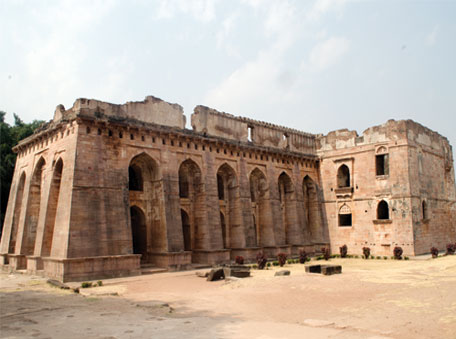
North of the Hindola Mahal are a series of scattered ruins leading to the Dilwara Khan Masjid. Built in 1405, this is the oldest surviving Islamic architecture of Mandu, and the only religious structure in the Royal Enclave complex.
Mandu Royal Palace: West of the Hindola Mahal and north of the Munj Talao is Mandu’s Royal Palace complex. Although in ruins, the complex still has the grandeur of the golden days of Mandu. At the entrance of the Royal Palace lies the step well of Chanpa Baodi, which is in relatively good condition, although the railing has been added by the ASI (Archaeological Survey of India). A subterranean passage connects the base of the well to a labyrinth of vaulted rooms, thus keeping them cool through the blistering summer. North of the Champa Baodi is the Hammam complex. The star-shaped opening adorning the dome of the Hammam complex allowed natural light to filter into the hammams.
Jal Mahal: South-west of the Royal Palace and on the furthest end of the Royal Enclave is the Jal Mahal. Barely visited by tourists, it is one of the most enchanting parts of the entire Royal Enclave. During the height of the monsoon when the Munj Talao is full to its brim, a narrow passage connects the Royal Palace to the Jal Mahal. The passage contains three pairs of stairs leading to the water on both sides. A favourite of the Mughal Empire Jahangir, the Jal Mahal has its own share of architectural beauty complete with swimming pools, water passages and arched passageways. The Royal Enclave also contains several other monuments including Gada Shah shop, Andheri Baodi and Ujjawala Baodi.
The Central Group
The Central Group, as the name suggests, is located at the centre of the fortified city of Mandu. Much smaller compared to the Royal Enclave, the Central Group contains some of the most important and beautiful architecture of Mandu.

Jami Masjid: The principal mosque of Mandu was conceived and executed on a magnificent scale covering an area of 88 sq. m. The entire construction stands on a plinth of 4.6 m above the ground and is approached by a grand flight of stairs. The construction of the mosque began during the reign of Hoshang Shah, and was subsequently completed by his successor Mahmud Khalji in 1454. On the western wall of the Masjid is a decorative miharb and next to it is a raised marble pulpit, from where the Imam leads the prayer. The pillars and the arches, along with the intricate lattice works create an interesting architectural mix.
Hoshang Shah’s Tomb: Behind or west of the Jami Masjid lies Hoshang Shah’s Tomb, India’s first marble structure and probably the inspiration behind the legendary Taj Mahal. The mausoleum stands on a square marble platform and is crowned by a gigantic dome. At the four corners are domed turrets. The interiors are beautiful with light filtering through the geometric and floral patterns of the intricate lattice work. At the centre lies the tomb of Hoshang Shah, and scattered on all sides are several other tombs.
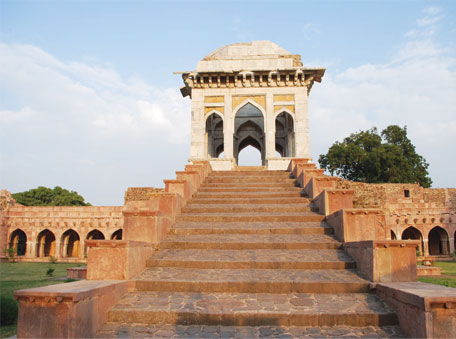
Ashrafi Mahal: Ashrafi Mahal is located on the other side of the road and bang opposite the Jami Masjid. The exact purpose of the mahal is not known, but historians opine that it served as a madrasa. Construction dates back to the reign of Mahmud Khalji (1436-69). The north–west corner of the Ashrafi Mahal once housed the victory tower or the vijay stambh, which was constructed by Mahmud Khalji on the occasion of his victory over the Rana of Mewar. The tower has long collapsed and the existing base reminds one of the flourishing days of Ashrafi Mahal. Behind the Ashrafi Mahal lies the tomb complex of Mahmud Khalji. The roof has long collapsed and only small sections of the wall still stand, guarding the tomb of one of the greatest rulers of central India.
The Darya Khan Mosque Group
This group of ruins are located south of the Central Group and is centred around the Darya Khan Tomb complex.
Darya Khan Tomb complex: Darya Khan was a minister in the court of Mahmud Khalji II, and today his tomb lies in a walled complex along with another tomb, a mosque, a pond and an inn. At the centre of the complex is the massive sand stone tomb of Darya Khan. The exterior was once decorated with colourful mosaic, but only traces of it remain today.
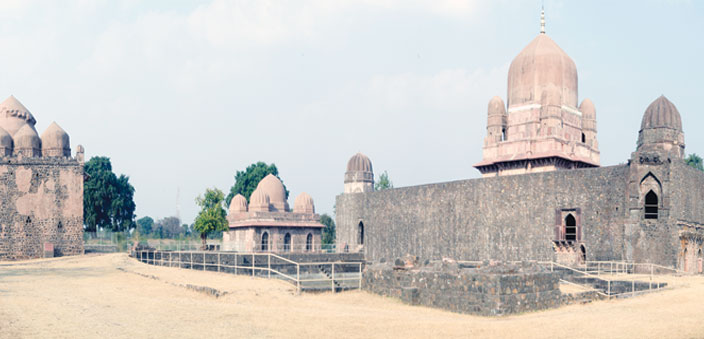
Hathi Paga Mahal: Literally meaning Elephant Leg Palace, the monument gets its name from the massive elephantine pillars at the four corners of the monument. These massive pillars are said to represent the leg of an elephant. It is located on the south-eastern side of the Darya Khan Complex, and is crowned with a massive dome. It was probably built as a pleasure resort, but later converted into a tomb. Next to the Hati Paga Mahal is a small mosque.
The Sagar Talao Group
This group is located on the eastern side of the huge lake Sagar Talao, and south of the Darya Khan Group. A massive unknown tomb greets visitors to the complex. Just behind it are the scattered ruins of several tombs, gardens, mosques and inns.
Dai ki Mahal and Dai ki Behan ki Mahal: Although called mahals, these are actually tombs of a royal wet nurse and her sister. Nothing is known about this celebrity nurse or date of construction of the tombs. Both the structures are crowned with gigantic domes. Both the tombs had extensive multicoloured mosaic work and traces can be seen to this day.
Caravan Sarai: Sarai means inn and since Mandu has been a trade centre for centuries, it attracted traders from far and wide. The scattered ruins of Mandu contain the remains of several inns or sarai. Out of these, the largest and the most well known is the Caravan Sarai, located bang opposite the Malik Mughith Mosque. It is an open courtyard with rooms on all sides, these rooms provided accommodation to traders coming from far and wide.
Malik Mughith’s Mosque: This is the most significant monument of the Sagar Talao group. It was built by Mahmud Khalji’s father Malik Mughith in 1432. The mosque consists of a central court enclosed by colonnades. The courtyard is surrounded by carved pillars taken from the ruins of Hindu temples.
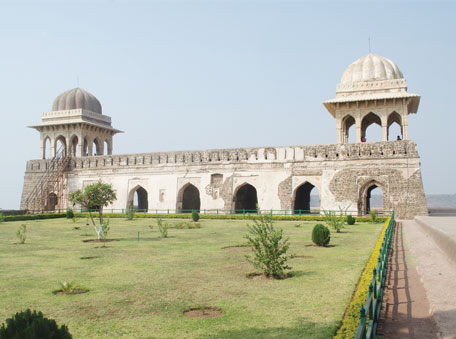
The Rewa Kund Group
The most enchanting and romantic of the Mandu groups, the Rewa Kund Group still speaks of the legend of Baz Bahadur and his consort Roopmati. In 1561 Adam Khan led the Mughal army against the Sultan of Malwa, Baz Bahadur. The two forces locked horns at the battle of Sarangpur. Baz Bhadur was no match for the mighty Mughal army and was soon defeated, inhumane plunder and torture followed as women were raped and children massacred. Adam Khan was prompted to conquer Malwa because of the beauty of Rani Roopmati, Baz Bahadur’s favorite wife and well known singer. Although Adam Khan took possession of Baz Bhadur’s harem, Roopmati committed suicide by consuming poison. Rewa Kund is an ancient artificial lake widened and rebuilt by Baz Bahadur. On the banks of the lake stands the palace of Baz Bahadur, and located on top of a nearby hill is Roopmati’s Pavilion.
Baz Bahadur’s Palace: Located on the banks of the Rewa Kund and at the foot of a hill lies the Baz Bahadur Palace. It was originally built by Sultan Nasiruddin Shah in 1509 and subsequently enlarged by Baz Bahadur. The palace is approached by a flight of stairs and the main part consists of an open courtyard with a floral shaped fountain in the middle. To the north of the palace, beyond the colonnade, projects an octagonal pavilion with arches. The spacious terrace is crowned with two chhatris or pavilions and offers a grand view extending all the way to Roopmati’s Pavilion.
Roopmati’s Pavilion: Located on a hill top, Roopmati’s Pavilion crowned with two chhatris, provide a grand view of the Nimar plains. It is said that on a clear day, the views can extend all the way up to the Narmada in the south. Today, Baz Bahadur’s Palace and Roopmati’s Pavilion stand as mute witnesses to the eternal love story of Baz Bahadur and Roopmati.
Miscellaneous monuments
The monuments of Mandu are so scattered that it is difficult to bring them under groups, so apart from the five above mentioned groups there are several scattered monuments all over Mandu, like the Lal Mahal and Neelkanth Palace. Mandu also houses the Lohani Caves dating back to the 11th–12th century. Mandu also contains some gigantic gateways including the Delhi Gate, Kamani Darwaza and Alamgir Gate.
So as the heat of summer sets in, it is best to start planning for your monsoon trip to Mandu. Follow the steps of Baz Bhadur and Roopmati, and lose yourself in the monsoon magic of Mandu.
Hanuwantiya
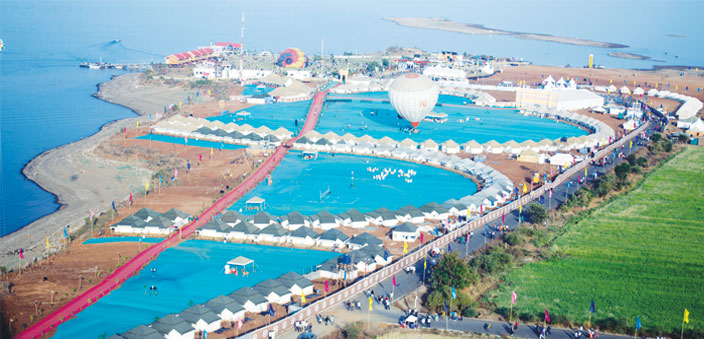
The Jal Mahotsav
In order to promote tourism in the state, the Madhya Pradesh Tourism Development Corporation (MPTDC) hosted the Jal Mahatsov, a ten-day water festival on the banks of Indira Sagar. The festival was inaugurated by the Chief Minister Shivraj Singh Chouhan on 11 February 2016.
The objective of the Jal Mahotsav was to provide ample opportunities to tourists to explore and experience the colourful customs of Madhya Pradesh that was portrayed through art, craft, folk music and dance along with mouth watering cuisine. But the main focus of Jal Mahotsav was adventure sports with special emphasis on water and aero sports.
The venue of this water festival was the Indira Sagar, one of the numerous artificial lakes formed by damming the mighty Narmada River. The lake named after former Prime Minister Indira Gandhi, who laid the foundation stone of the dam a week before her assassination, is the largest man-made lake in the country. Hanuwantiya, a small village on the banks of the lake played host to the Jal Mahotsav. The Hanuwantiya Tourist Complex run by the MPTDC houses five cottages facing the lake, each equipped with two luxurious bedrooms. The complex also houses a large lawn along with a boat house, providing speed boat rides in Indira Sagar throughout the year.
During the Jal Mahotsav held during 11-21 Feb, 2016, the area next to the Hanuwantiya Tourist Complex was turned into a tented city. The spacious air-conditioned tents, with attached baths, were an ultimate luxury for the guest. The reception area was designed as the Sanchi Stupa, while the conference and dinning-hall represented the Gawalior Fort. The entire area was eco-friendly and golf carts and cycles were the only forms of transport within the tented city.
Adventure tourism at its best
The main focus of the Jal Mahotsav was to promote adventure tourism. Several adventure activities were brought under the same roof during the 10-day-long Jal Mahotsav. Since the Hanuwantiya Tourist Complex is situated next to a large water body, the primary focus was on water adventure activities. Speed boat rides in the Indira Sagar was the most popular among the water sports activities. The boats took tourists into the lake, providing a great view of the Hanuwantiya Tourist Complex. Those seeking an adrenalin rush could opt for the water scooter.

The banana boat was another option for adventure seekers. The banana boat consists of a powered inflatable boat consisting of two banana shaped tube. It can accommodate about 8-10 people and is towed by a speed boat. Water zorbing is another thrilling activity. Water zorbing consists of a cylindrical shaped inflated transparent container holding 3 to 4 riders. It floats in water and is rotated by the riders. But the ultimate water adventure activity was parasailing, where a person is towed behind a boat while attached to a specially designed parachute. Parasailing provides an amazing aerial view of the Indira Sagar Lake. Everything on water is not meant for the adrenalin junkies, there are activities for the faint-hearted too! The cruise ride in the blue waters of the Indira Sagar Lake should not be missed.
The massive dam on the Narmada River submerged over 90,000 hectares of land, half of which consisted of dense forests, and created the Indira Sagar Lake. Fortunately, a few pockets of land have survived as islands on the Indira Sagar Lake, which now has about 10 such islands, of which, Boriamal Tapu (Tapu means island in local language) houses a tented accommodation for trekkers and bird watchers.
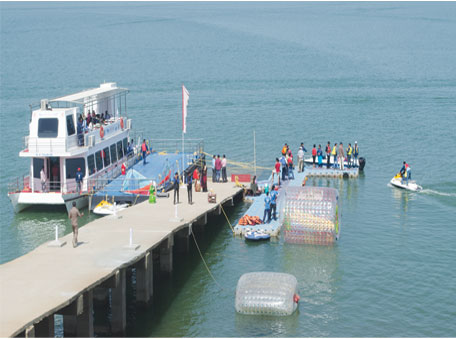
These tents provide only basic amenities like sleeping bags, but they provide an opportunity of spending a night in the lap of nature. In the morning, visitors can opt for a trek along the undulating trails of the island, spotting birds and other forms of wildlife. The adventure activities of the water festival is not restricted to water adventure only. There are land adventure activities also, and include activities like wall climbing. A zipline connects the artificial rock to the banks of the lake, providing a thrilling ride for adventure seekers. Land parasailing is another interesting activity of the Jal Mahotsav, where the participant is pulled by a jeep and the parachute lifts the person into the sky. The kids also had their very own adventure zone within the tented complex. It had activities like Burma Bridge (a specially designed rope bridge), net walking and tyre swings.
The skies above the Indira Sagar provide the most popular adventure activities. The para-motor and hot air ballooning were the most sought after adventure activities in the entire Jal Mahatsov. Two to three hot air balloons operated in the Hanuwantiya complex, providing rides to hundreds of adventure seekers. But due to enormous crowd pressure the rides were shortened to a height of about 40-50 feet, providing a view of the tented complex.
Baoab (Adansonia digitata) tree, a native of Africa which gives the impression of having its roots upside down, is found in abundance in the Mandu plateau. Its fruit, locally known as the Khurasani Imli, produces a refreshing drink during the summer months. The flesh of the baobab fruit is dried and powdered. The powder is mixed in water with a dash of sugar to produce the juice. It’s a sour drink, and especially refreshing during summer.
But the greatest aerial views were obtained from the para motor, which consists of a frame that combines the motor, propeller, harness (with integrated seat) and cage. The para-motor, which soared to a height of 300 feet, provided an unbelievable bird’s eye view of the Hanuwantiya Tourist Complex. The para-motors and the hot air balloons were not the only flying objects in the sky above Indira Sagar, in fact the most colourful objects in the sky were kites, which came in every possible shape and size. The kites created a dramatic spectacle with the deep blue sky above the endless waters of the Indira Sagar. The kite flyers, who came all the way from Gujarat, were extremely friendly, and enthusiastic tourists were provided opportunities to fly the kites.
Rates of Adventure activates at Jal Mahotsav 2016
1. Para-motor Rs. 500
2. Hot air ballooning Rs. 500
3. Parasaling (water) Rs. 500
4. Parasailing (land) Rs. 500
5. Rock climbing wall Rs. 100
6. Zipline Rs. 100
7. Jet-ski Rs. 400
8. Banana boat Rs. 150
9. Zorbing Rs. 100
10. Motor boat (3 persons) Rs. 210
11. Cruise Rs. 150
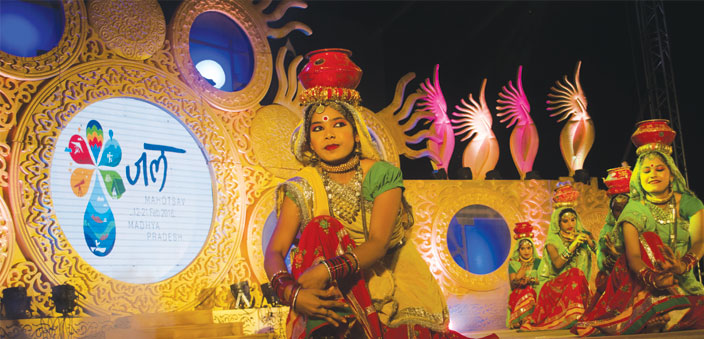
Jal Mahotsav was not all about adventure, and the leisurely tourist could settle down for a bullock cart ride. A street magician, with an amazing assortment of tricks, entertained the crowd in the tent complex area. Foodies had their own entertainment in the food court, while the shopaholics were busy in the craft bazaar.
Getting in and out: Indore (95 km) is the nearest airport and railhead. Direct buses from Indore to Mandu are rare, so it is best to break journey at Dhar. However, cars can be booked for the trip.
Places to stay: Mandu has several hotels. Madhya Pradesh Tourism Development Corporation (MPTDC) operates two hotels in Mandu. There are several private hotels too.
Getting around: At least two days are required for exploring Mandu. The sites can be explored by car, which the hotels will arrange.
Best time to visit: Apart from the scorching summer, Mandu can be visited throughout the year, though monsoon is the best time to explore the enchanting ruins and natural landscapes of Mandu.
The evening had cultural programmes, where artistes from different districts of Madhya Pradesh performed on the stage. The first edition of Jal Mahotsav turned out to be a great success and the MPTDC wants to make it a regular annual activity like the Khajuraho Dance Festival. The Hunawantiya Tourist Complex will remain open throughout the year along with the speed boat rides on the Indira Sagar Lake. Here, double bed rooms are priced at Rs. 3,290 (breakfast included). The Hanuwantiya tour can be clubbed with Bhopal, Indore and Mandu.

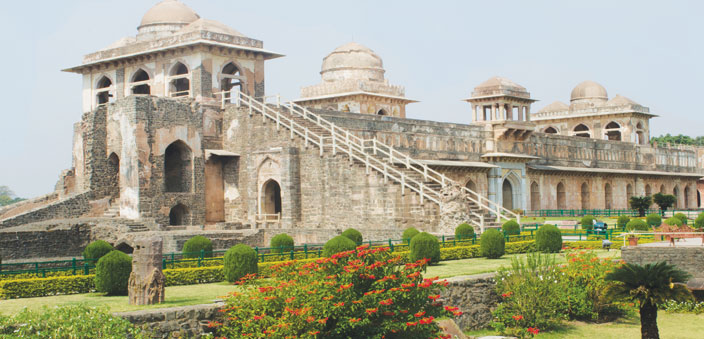
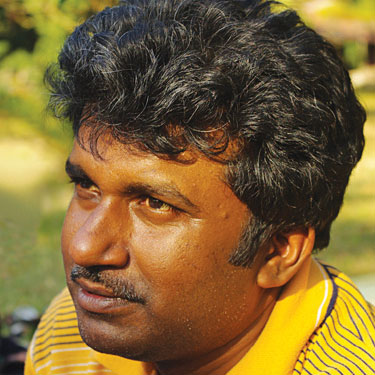 [/column]
[/column]